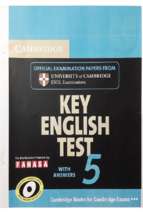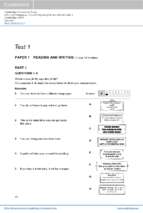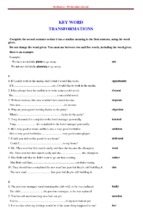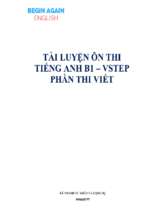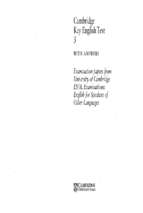VIETNAM NATIONAL UNIVERSITY, HANOI
VIETNAM JAPAN UNIVERSITY
NGUYEN THI HONG DUONG
INNOVATIVE APPROACH IN
DEVELOPING A DISASTER
PREPAREDNESS PLAN FOR PRIMARY
SCHOOLS IN DA NANG CITY IN THE
CONTEXT OF CLIMATE CHANGE
MASTER’S THESIS
Hanoi, 2020
ii
VIETNAM NATIONAL UNIVERSITY, HANOI
VIETNAM JAPAN UNIVERSITY
NGUYEN THI HONG DUONG
INNOVATIVE APPROACH IN
DEVELOPING A DISASTER
PREPAREDNESS PLAN FOR PRIMARY
SCHOOLS IN DA NANG CITY IN THE
CONTEXT OF CLIMATE CHANGE
MAJOR: CLIMATE CHANGE AND DEVELOPMENT
CODE: 8900201.02QTD
RESEARCH SUPERVISOR:
Dr. TONG THI MY THI
Hanoi, 2020
iii
Pledge
I guarantee that this thesis is my own research result and has not been published.
The use of results of other research and other documents must comply with the
regulations. Citations and references for documents, books, research papers and web
pages must be on the list of references of the thesis.
Author of the thesis
Duong Nguyen Thi Hong
i
Table of contents
Pledge ................................................................................................................................i
Table of contents ..............................................................................................................ii
List of tables ....................................................................................................................iv
List of figures ................................................................................................................... v
The list of acronyms ........................................................................................................vi
Acknowledgement ..........................................................................................................vii
CHAPTER 1. INTRODUCTION .................................................................................... 1
1.1. The necessity of the research ............................................................................ 1
1.2. Research objectives and research objects .............................................................. 2
1.3. The research questions and hypotheses ................................................................. 3
1.3.1. The questions of research ............................................................................... 3
1.3.2. The hypotheses of research ............................................................................. 4
1.4. Research location................................................................................................... 4
1.5. Literature review ................................................................................................... 7
1.5.1. Theoretical basis ............................................................................................. 8
1.5.2. Practical basis ............................................................................................... 15
1.6. Framework of the Master‟s thesis ....................................................................... 18
CHAPTER 2. RESEARCH METHODS ....................................................................... 20
2.1. Document analysis method ................................................................................. 20
2.2. Sociological Research Methods .......................................................................... 22
2.2.1. Questionnaire survey .................................................................................... 22
2.2.2. Key interview ................................................................................................ 25
2.2.3. Focus group discussions ............................................................................... 26
2.2.4. Observation ................................................................................................... 26
2.3. Methods of data analysis ..................................................................................... 27
2.4. Method of maps and charts ................................................................................. 27
CHAPTER 3. DISASTERS RESILIENCE LEVEL OF PRIMARY SCHOOL IN DA
NANG CITY .................................................................................................................. 29
3.1. Result of disaster resilience level of primary schools in Da Nang city............... 29
3.2. Disparities in disaster resilience between schools have the highest and lowest
scores .......................................................................................................................... 39
3.3. Disaster resilience among coastal, low plains, and mountainous area ................ 47
3.4. The change of disaster resilience of primary schools from 2012 to 2019 .......... 56
CHAPTER 4. BUILDING A DISASTER PREPAREDNESS PLAN FOR SCHOOL 64
4.1. Innovative approach to develop a disaster preparedness plan for the school ..... 64
4.2. Case studies in developing a disaster preparedness plan for schools .................. 66
4.2.1. Develop a disaster preparedness plan for the school in coastal area - Doan
Thi Diem primary school ........................................................................................ 67
ii
4.2.2. Develop a disaster preparedness plan for the low plains school - Ngo Quyen
primary school ........................................................................................................ 75
4.2.3. Develop a disaster preparedness plan for the mountainous school – Lam
Quang Thu primary school ..................................................................................... 83
CONCLUSION .............................................................................................................. 91
References ...................................................................................................................... 96
List of publishcations by the author ............................................................................... 99
Appendix ...................................................................................................................... 100
Appendix 1: Matrix of Learning Outcomes for the Master's thesis ......................... 100
Appendix 2: General information of 97 primary schools in Da Nang city .............. 102
Appendix 3: Survey on disaster resilience of primary schools ................................ 107
Appendix 4: The list of Dimension, parameter, and variables used to assess the
school's disaster resilience ........................................................................................ 133
Appendix 5: Score of parameters of primary schools in Da Nang city................... 137
Appendix 6: The list of solutions for 3 pilot primary schools ................................. 141
Appendix 7: Parameter score of 3 areas ................................................................... 149
Appendix 8: Key interview ...................................................................................... 151
Appendix 9: Photos in the research process ............................................................. 152
iii
List of tables
Table 1.1. The number of primary schools divided into 3 areas ................................................ 7
Table 2.1. Explanation the school's level of disaster resilience ................................................ 24
Table 2.2. Information about focus group discussions ............................................................. 26
Table 3.1. Lessons learnt from TK34 ....................................................................................... 46
Table 3.2. Disaster resilience of schools divided by region ..................................................... 47
Table 3.3. The average score of the parameters in the " Physical conditions" of the three areas
.................................................................................................................................................. 48
Table 3.4. The average score of the parameters in the "Human resources" of the three areas . 50
Table 3.5. The average of the parameters in the "Institution" of the three areas ...................... 51
Table 3.6. The average score of the parameters in the "External relationship" of three areas . 53
Table 3.7. The average of the parameters in the "Natural conditions" of the three areas ......... 54
Table 3.8. The list of parameter has high corelation to disaster resilience level ...................... 56
Table 3.9. The change in dimensions's score between 2012 - 2019 ......................................... 56
Table 3.10. The change in parameters score between 2012 - 2019 .......................................... 57
Table 3.11. Changes of temperature (oC), annual rainfall (%), and Sea level rise (cm) in Da
Nang at the end of the 21st century compared to the baseline period ....................................... 63
Table 4.1. List of selected schools for piloting disaster preparedness planning ....................... 66
Table 4.2. Implementation time (year) for solutions in Doan Thi Diem primary school ......... 69
Table 4.3. Evaluate the feasibility, effectiveness, priority and funding for solutions .............. 74
Table 4.4. Implementation time (year) for solutions in Lam Quang Thu primary school ........ 76
Table 4.5. Evaluate the feasibility, effectiveness, priority and funding for solutions .............. 82
Table 4.6. Implementation time (year) for solutions in Lam Quang Thu primary school ........ 85
Table 4.7. Evaluate the feasibility, effectiveness, priority and funding for solutions .............. 90
iv
List of figures
Figure 1.1. The research framework ......................................................................................... 18
Figure 2.1. The Methodological framework ............................................................................. 21
Figure 2.2. Location map of 97 primary schools in Da Nang city ........................................... 22
Figure 2.3. Conduct survey with the director of Ngo Gia Tu primary school .......................... 24
Figure 2.4. Conduct survey with the vice-director of Phan Phu Tien primary school ............. 24
Figure 2.5. Process of implementing key interview method .................................................... 25
Figure 2.6. Interview Ngu Hanh Son's DoET staff ................................................................... 26
Figure 2.7. Interview Director of Dinh Bo Linh primary school .............................................. 26
Figure 2.8. Interview a student of Doan Thi Diem primary school .......................................... 26
Figure 2.9. Data analysis process .............................................................................................. 27
Figure 3.1. Disaster resilience level of 96 primary schools, Da Nang city .............................. 30
Figure 3.2. The average score of the parameters ...................................................................... 31
Figure 3.3. The level of periodic testing with teaching equipment .......................................... 32
Figure 3.4. The average of the parameters ................................................................................ 40
Figure 3.5. Comparison of natural disaster resilience between three regions .......................... 46
Figure 3.6. Dimensions and indicators score of 2012 (grey line) and 2019 (red line) ............. 58
Figure 3.7. Improvement of variables of "School building" ..................................................... 59
Figure 3.8. Percentage of equipment that is replaced or repaired immediately after a natural
disaster occurs (2019) ............................................................................................................... 60
Figure 4.1. Steps to build disaster preparedness plan ............................................................... 64
Figure 4.2. The role of teachers in implementing disaster preparedness plan .......................... 72
Figure 4.3. The role of students in implementing disaster preparedness plan .......................... 72
Figure 4.4. The role of parents in implementing disaster preparedness plan ........................... 72
Figure 4.5. The role of community in implementing disaster preparedness plan ..................... 72
Figure 4.6. The role of authority in implementing disaster preparedness plan ........................ 73
Figure 4.7. The role of DoET in implementing disaster preparedness plan ............................. 73
Figure 4.8. The role of NGO in implementing disaster preparedness plan .............................. 73
Figure 4.9. The role of teachers in implementing disaster preparedness plan .......................... 79
Figure 4.10. The role of students in implementing disaster preparedness plan ........................ 79
Figure 4.11. The role of parents in implementing disaster preparedness plan ......................... 80
Figure 4.12. The role of community in implementing disaster preparedness plan ................... 80
Figure 4.13. The role of authority in implementing disaster preparedness plan ...................... 80
Figure 4.14. The role of DoET in implementing disaster preparedness plan ........................... 80
Figure 4.15. The role of NGO in implementing disaster preparedness plan ............................ 80
Figure 4.16. The role of teachers in implementing disaster preparedness plan ........................ 88
Figure 4.17. The role of students in implementing disaster preparedness plan ........................ 88
Figure 4.18. The role of parents in implementing disaster preparedness plan ......................... 88
Figure 4.19. The role of community in implementing disaster preparedness plan ................... 88
Figure 4.20. The role of authority in implementing disaster preparedness plan ...................... 88
Figure 4.21. The role of DoET in implementing disaster preparedness plan ........................... 88
Figure 4.22. The role of NGO in implementing disaster preparedness plan ............................ 89
v
The list of acronyms
AADMER ASEAN Agreement on Disaster Management and
Application Emergency Response
CC
Climate Change
CCFSC
Central Committee for Flood and Storm Control
CRED
The Center for Research on the Epidemiology of
Disasters
DoET
Department of Education and Training
DRR
Disaster Risk Reduction
DRRE
Disaster Risk Reduction Education
IPCC
Intergovernmental Panel on Climate Change
NGO
Non-Governmental Organization
MCCD
Master program of Climate Change and Development
MoET
Ministry of Education and Training
MONRE
Ministry of Natural Resources and Environment
SDRA
School's Disaster Resilience Assessment
SFDRR
Sendai Framework for Disaster Risk Reduction 2015 2030
UN
United Nations
UNISDR United Nations International Strategy for Disaster
Reduction
vi
Acknowledgement
The research presented in this Master thesis was carried out at the Master
program of Climate Change and Development (MCCD), Vietnam Japan University.
During my studies at MCCD, I accumulated a lot of knowledge and skills, which not
only helped me to be able to successfully complete this research but also helped a lot
with my work. In the course of my studies, I have gained the necessary knowledge and
basic, interdisciplinary methodologies to assess and address issues related to climate
change mitigation, adaptation to Sustainable development at global, national, and local
levels. From there, I can apply that knowledge to my research topic, offer new ideas on
climate change response, approach disaster preparedness planning from a CC
adaptation perspective, and propose solutions for it. During the research process, I
worked with and cooperated with schools, the Department of Education and Training
of Da Nang City. Work skills, communication skills, time management, independent
work, and the seriousness of the work I learned from MCCD helped me to complete
this research well.
Firstly, I would like to thank my supervisor, Dr. Thi Tong for her invaluable
guidance, encouragement, and support throughout the Master thesis process. Dr. Thi
gave me extremely perceptive, helpful, and appropriate expert guidance, particularly in
reading and responding to the drafts of my work quicker than I had anticipated.
Secondly, I would like to thank all the people who were involved in the research
process. All the directors of 97 primary schools and DoET's staff in Da Nang city, who
helped in conducting surveys, interviews, and setting up the fieldwork.
Thirdly, the teachers in the MCCD, Vietnam Japan University. Teachers not
only equip students with valuable specialized knowledge in the field of climate change
research but also create favorable conditions and provide dedicated guidance to
students during the dissertation process.
Last but not least, I would like to thank my family and friends in the MCCD for
helping me complete this thesis.
vii
CHAPTER 1. INTRODUCTION
1.1.
The necessity of the research
Climate change (CC) around the globe began to affect and directly affect the
weather and climate of Vietnam with natural disasters that are more abnormal and
intense. Vietnam is the 6th country in the world affected by extreme weather events in
the context of CC (period 1999 - 2018) (Carter, 2008). In the context of CC, the
frequency and intensity of natural disasters are increasing, causing great damages of
people and properties, adversely affecting all fields (MONRE, 2016). The impact of
CC in the form of natural disasters can seriously affect Vietnam's education system and
threaten the achievement of goal 4 - The Quality of Education in the Sustainable
Development Goals.
Education is one of the sectors most severely affected by climate disasters in
Vietnam (MOET, 2011). In a country like Vietnam, natural disasters such as storms
and floods can happen unexpectedly. Therefore, disaster preparedness is the first and
most important step to minimize damages, especially in the context of primary schools,
where students are underage disasters‟ response. Good disaster preparedness will help
both reducing the damages and making recovery quicker. Disaster preparedness is
important for disaster managers, as, in the event of an emergency, the response to a
disaster or natural disaster depends very much on the disaster preparedness plan
(International Federation of Red Cross and Red Crescent Societies, 2000).
Although natural disasters occur every year, primary schools still have confused
of handling before, during, and after a disaster. The recovery takes a lot of time, so
interrupt learning and the quality of schools learning. Primary schools prepare disaster
prevention plans at the beginning of each school year. Based on the country's National
Action Plan to Respond to Climate Change and Disaster Risk Reduction (DRR), the
Ministry of Education and Training (MoET) will make a plan, and the Departments of
Education and Training (DoET) will follow that plan to bring down the DoET of each
district and the basis for the school's plan. The whole process is conducted based on a
1
top-down approach, and there is no evaluation of school conditions or any involvement
of people involved in disaster preparedness of schools such as teachers, students,
parents, communities, and so on.
From this fact, there is a need to change the way in which schools prepare
disaster plans. Instead of a top-down approach, a bottom-up approach is needed. This
study is an attempt to develop an innovative approach in developing disaster
preparedness plan in schools. In order to do that, the study used the School's Disaster
Resilience Assessment (SDRA) method, which includes five indicators: "Physical
conditions", "Human resources", "Institutional issues", "External relationships" and
"Natural conditions" (Tong S. R., 2012). Results from the assessment of disaster
resilience level of primary schools in Da Nang city is utilized to point out the
problems, to identify factors that affecting the primary schools's ability to cope with
natural disasters. On this basis, the study figures out a roadmap to improve resilience of
the schools.
In this thesis, the disaster resilience level of primary schools in Da Nang City,
the differences in disaster resilience level among the coastal, low plain, and
mountainous areas, and the changes in disaster resilience level of primary schools from
2012 to 2019 will be presented. From there, the study selects three pilot primary
schools and develops disaster preparedness plans for them. Difficulties and challenges
in the pilot process at selected schools are summarized in this study as a basis for
building an innovative approach to develop a disaster preparedness plan. The results of
this study is expected to contribute to improve the resilience level of primary schools
through well establishment of disaster preparedness plan development, which in turn
will help schools effectively respond to natural disasters, to adapt to CC, and to achieve
Goal 4 in 17 Sustainable Development Goals on Sustainable Quality Education.
1.2. Research objectives and research objects
Research objectives
2
The main objective of the research is to develop an innovative approach
in developing a disaster preparedness plan that can be applied to primary schools in the
context of CC.
To accomplish the above objective, the research tasks are set out as
follows:
Carrying out key interviews with the representative of Da Nang DoET to apply
for permission to work and adjust the questionnaire to suit the primary schools
in Da Nang City;
Carrying out key interviews with schools's disaster managers and representative
of DoET's in 7 districts;
Sending questionnaires to 97 primary schools and getting back the questionnaire
(contact the schools for correction if any);
Compare disaster resilience level between schools has the highest score and
lowest score; among three areas; between 2012 and 2019;
Building a disaster preparedness plan for schools to improve the resilience of
education to disaster risks and testing in 1 school in each areas;
Focus group discussions with relevant stakeholders to propose and prioritize
solutions for school disaster resilience;
Objects of the research
The object of research is to develop an innovative way to build disaster
preparedness plan for primary schools in Da Nang city.
1.3. The research questions and hypotheses
1.3.1. The questions of research
What are the most important factors deciding the disaster resilience level of
primary schools in Da Nang City?
3
How are the differences between the highest and lowest school's disaster
resilience level; among three geographical areas (coastal, low plains, and
mountainous); and between 2012 and 2019?
How to develop an effective disaster preparedness plan for primary schools in
Da Nang City?
1.3.2. The hypotheses of research
The resilience level of primary schools in Da Nang City is depending mostly in
"Human resources" dimension;
The difference between schools with the highest and lowest scores is mainly in
the “Human resources” dimension; There is no significant difference in natural
disaster resilience of the three regions; There is a significant improvement in
scores in all parameters of 2019 compared to 2012;
An innovative approach to develop a disaster preparedness plan for primary
schools includes (1) assessment of schools‟ disaster resilience using SDRA
method, (2) proposing solutions to improve disaster resilience level using expert
consultation, (3) involvement of stakeholders to evaluate and choose the most
suitable solutions for schools; (4) re-assessment the schools‟ disaster resilience
and the plan every year to update the disaster preparedness plan.
1.4. Research location
The study was conducted in 97 primary schools in Da Nang.
Time: from April 2019 to April 2020.
Da Nang is a coastal city in the Central region of Vietnam. Geographic location
is a factor that makes Da Nang potentially severely affected by natural disasters. From
1999 to 2009, there were 23 typhoons, 35 floods, injuring 277 people, lost 19 people
and killed 200 people in Da Nang city, total economic losses amounted to 6,803.5
billion VND (CCFSC, 2009). The biggest storm causing damage to Da Nang was the
2006 Xangsane typhoon, causing economic losses of about VND 5,290 trillion (over
4
USD 300 million), destroying 9,906 houses, 73,874 houses damaged and 2,760 schools
affected (CCFSC, 2006).
In recent years, in order to proactively prevent and respond effectively to natural
disasters and situations of accidents and disasters caused by serious floods, the People's
Committee of Da Nang City issued a directive request departments, agencies, districts
in the city to develop disaster prevention plans, raise public awareness about disaster
prevention and fighting; organize drills on natural disaster prevention and control in
localities to draw experience. The Da Nang People's Committee has also issued
Decisions and Plans to implement the Government's instructions on Disaster
Prevention and Response to CC.
Regarding education, Da Nang's DoET has organized many activities to
integrate contents related to CC in the subjects at all levels, combining extracurricular
activities to provide knowledge on CC, building awareness for students on responding
to CC. Da Nang has also strengthened the "Physical conditions" of almost schools
located in vulnerable areas such as coastal, mountainous and low plains areas.
Although there have been extracurricular activities on disaster risk reduction education
(DRRE) for some schools, the DRRE activities of schools in Da Nang city have not
been synchronized. There is no specific plan for each school, only the "Handbook of
DRRE for teachers", which has not specified specific steps to respond to natural
disasters for teachers, students, parents. This limits the ability of schools to respond to
disasters, disrupting, and affecting the quality of education.
Primary schools play an important role in training knowledge, disseminating
skills in natural disaster prevention, fighting and reduction, and CC response in schools
(Prime Minister, 2018). Primary schools in Da Nang city has been applying local
regulations on natural disaster prevention and control. However, the application of
these regulations is only moderate. This is reflected in the school's response to natural
disasters.
5
Every year, Da Nang's education sector is affected by the floods that occur often
at the beginning and end of the school year. Dien Hong, Hoang Du Khuong, Thai Thi
Boi and Ong Ich Duong primary school (Cam Le district) were hit by Hurricane
Katrina, destroyed roofs, broken trees, causing damage to nearly VND 50 million each
school in 2009 (Cam Le DoET, 2009). Typhoon Nari in October 2013 caused heavy
rainfall and all primary schools in the center of city had to closed. One month later, in
November 2013, primary schools in Hoa Vang district, including Lam Quang Thu
primary school, were seriously flooded due to floods from the Tuy Loan River near the
school. Especially the most recent three rainy seasons, at the end of 2017, 2018 and
2019. In November 2017, heavy rains caused Hoa Vang district, a region of low
terrain, to be flooded in a large area. In December 2018, floodwaters flooded many
schools in Hai Chau, Hoa Vang, Thanh Khe and Ngu Hanh Son districts and were
closed. In less than a month, Lam Quang Thu primary school had to close three times
(October 20th, November 1st, and November 17th, 2018) (Hoa Vang DoET, 2018).
Heavy rains in December 2018 caused extensive flooding for central districts of Da
Nang City. Nearly 2000 students of primary schools in Hai Chau District, Huynh Ngoc
Hue and Huynh Thuc Khang primary school (Thanh Khe District) had to close due to
the heavy rain. Besides, Nguyen Dinh Chieu primary school (Thanh Khe District) was
flooded many offices, the entire archives of the school were wet (Thanh Khe DoET,
2018). By the end of 2019, floods also affected schools in Da Nang. In particular, Lam
Quang Thu primary school had to close three times within a month due to flooding.
Natural disasters cause serious damage to facilities, teaching equipment, and directly
threaten the safety of teachers and students when going to schools in flooded
conditions. Whenever a disaster strikes, classroom facilities and the quality of
education are affected. Phan Dang Luu primary school was flooded to the table (in
2018), many teaching aids were soaked in water, documents and records were wet.
Primary schools Dien Hong, Hoang Du Khuong, Thai Thi Boi, Ong Ich Duong of Cam
Le district were affected by the storm (2009-2010 school year), the costs amounted to
VND 50 million each. Although natural disasters occur every year, schools still have
the embarrassment of handling before, during, and after a disaster occurs. Disaster
6
recovery also takes time, affecting learning. All schools prepare a disaster preparedness
plan at the beginning of each school year, however, the plan is at a sketchy level,
without assigning tasks to specific people and “Human resources” nor finance for
disaster preparedness is available.
The study was conducted at all primary schools in six urban districts and one
rural district in Da Nang City. In the school year 2018-2019, the number of public
primary schools are 97, with about 92,000 students. For the purpose of comparing
disaster resilience among areas, primary schools in Da Nang City are divided into three
areas: coastal, low plain, and mountainous areas based on the location of the schools
and the distance from the school to the coast. Table 1.1 shows the number of schools
located in three areas.
Table 0.1. The number of primary schools divided into 3 areas
Area
Hai
Chau
Thanh Son
Khe
Tra
Coastal
Low plain
18
0
16
0
13
0
Ngu
Hanh
Son
8
0
0
0
16
13
Mountainous 0
18
Total
Lien
Chieu
Cam
Le
Hoa
Total
Vang
13
0
2
8
1
9
71
17
0
0
0
9
9
8
13
10
19
97
1.5. Literature review
This part presents an overview of disaster management and disaster
preparedness plans to better understand the context of research around the world and in
Vietnam as it relates to the research goal. This aims to provide a basic picture of the
current state of school disaster management and related issues. The first part consists of
research in the world, the second part is the research in Vietnam and the last is the
research site.
7
1.5.1. Theoretical basis
1.5.1.1. Concepts of the research
The term disaster origin is the French word "Desastre" which is a combination
of two words „des‟ meaning bad and „aster‟ meaning star. So the term refers to "Bad
star". United Nations (UN) defines
that
Disaster is a serious disruption of the
functioning of a community or a society involving widespread human, material,
economic or environmental losses and impacts, which exceeds the ability of the
affected community or society to cope using its own resources (UN, 2009).
The International Bank for Reconstruction and Development declares that
natural disasters, such as floods, earthquakes and droughts, are always part of the
natural cycle everywhere in the world (The International Bank for Reconstruction and
Development , 1999). The impact of natural disasters is enormous, resulting in the
death and destruction of houses and socio-economic infrastructure (Mileti, DS , 1999).
Disaster management includes organizing, planning, and applying actions to
prepare for, respond to or recover from a disaster (UNDDR, 2017). This is a complex
process, revolving around four interdependent steps, including preparation, reaction,
recovery and mitigation. Disasters occur between steps of preparation and response.
Department for International Development (2011) defines Disaster Resilience as
the ability of countries, communities and households to manage change, by
maintaining or changing living standards in the face of shocks or stress - like
earthquakes, droughts or violent conflicts - without lasting impact. UNISDR (2008)
defines Disaster Resilience as the ability of a system, community or society to be
exposed to hazards to adapt, by resisting or changing to maintain functional and
structural acceptance (UNISDR, 2018).
As such, Disaster Resilience is generally a community's ability to resist, or
accept disaster. To help both reducing the dramatically and making recovery quicker, a
Good disaster preparedness is needed. Disaster preparedness is important for disaster
managers, as, in the event of an emergency, the response to a disaster or natural
8
disaster depends very much on the disaster preparedness plan. Disaster preparedness is
often considered to include measures that allow governments, organizations,
communities and individuals to respond quickly and effectively to disaster situations
(International Federation of Red Cross and Red Crescent Societies, 2000).
1.5.1.2. Disaster management
Herzog indicate that catastrophic impacts can be mitigate by mitigation efforts
or preparation planning (Herzog, 2007). Yodmani shows that carpet management
activities Graphics have evolved from most of the top-down relief and response
approaches. Disaster management in the past mainly dealt with natural disasters and
recovery, while disaster risk management encapsulated all disaster management
components (prevention, preparation, mitigation, and response) (Yodmani, 2001)
The level of readiness for a disaster situation that can occur for a given
community is called resilience. Increased resilience is needed to reduce disaster
impacts (Haworth, Bruce, Whittaker, & & Read, 2018).
Disaster management is important because it includes measures that not only
help relief and recovery, but also reduce disaster risk in the community (Ngcamu &
Sibongiseni, 2011). The Center for Research on the Epidemiology of Disasters (CRED)
declares declares that disaster management is essential for all countries as it can avoid
and minimize the impact of disasters. However, disaster preparedness often fails
because it is often not based on evidence or subject matter. It suggests that an
evaluation of the subject's ability is required before conducting disaster preparedness
planning (Guha-sapir, L.V.Parry, O.Degomme, Joshi, & Arnold, 2006).
A number of disasters can be prevented and mitigated through improved disaster
management capacity to address different aspects of prevention, preparation,
mitigation, response, recovery and recovery. Holloway argues that disaster risk
reduction is the systematic development and application of policies, strategies and
practices to mitigate vulnerabilities and disaster risks across society to prevent or limit
the adverse effects of hazards, in the context of sustainable development (Holloway,
9
2003). Haddow et al. emphasize that risk reduction, emergency preparedness and
recovery preparation practices can reduce losses (Jane A. Bullock, 2006).
All components of disaster management such as mitigation and preparation
should be modeled to simplify all risk mitigation processes in local government. In
South Africa, the local government is responsible for implementing and maintaining a
comprehensive, full-risk disaster management program, ensuring the following
components in disaster management; mitigation; preparation; react; aid; and
rehabilitation (Zyl, 2006).
Bullock had found another way to reduce the impact of catastrophes by applying
emergency precautions, which can be defined as pre-disaster actions, providing human
force and material needed to support reactions at the time of the disaster. The first step
in emergency preparedness is a community vulnerability analysis to identify
emergency response requirements that must be met by performing four basic
emergency response functions, including: ( 1) emergency assessment actions, such as
forecasting storm speed to determine potential disaster impacts; (2) hazardous
activities, such as sandbags surrounding buildings, are short-term actions to protect
property; (3) population protection actions, such as warnings and evacuations, to
protect people from impact; and (4) incident management actions, such as liaison
between feedback agencies (Jane A. Bullock, 2006).
In the study of Nahid Aghaei (2018) a systematic review was conducted to
assess and aggregate the evidence on the strategies (Allen, 2006) for DRRE conducted
in December 2016. Although most countries have launched DRR educational activities,
these actions are not enough, and there are some gaps between what it should and what
should be. More effective teaching and learning strategies are needed to increase the
effectiveness of preparatory and DRR activities at all community levels (Nahid Aghaei,
2018).
10
- Xem thêm -




